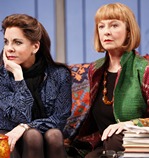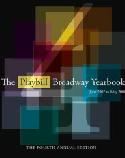SITE GUIDE
SEARCH
REVIEWS
REVIEW ARCHIVES
ADVERTISING AT CURTAINUP
FEATURES
NEWS
Etcetera and
Short Term Listings
LISTINGS
Broadway
Off-Broadway
NYC Restaurants
BOOKS and CDs
OTHER PLACES
Berkshires
London
California
New Jersey
DC
Connecticut
Philadelphia
Elsewhere
QUOTES
TKTS
PLAYWRIGHTS' ALBUMS
LETTERS TO EDITOR
FILM
LINKS
MISCELLANEOUS
Free Updates
Masthead
A CurtainUp Connecticut Review
The Breath of Life
|
You do it to give significance to things that don't have significance
— Madeleine on why Frances writes.
|

Stockard Channing & Jane Alexander
(Photo: Carol Rosegg)
|
Channing is Frances Beale, a novelist having found fame later in life, who calls on her former husband's lover Madeleine Palmer (Alexander) to test out the idea of writing a memoir about their experiences. Madeleine, who has secluded herself on the Isle of Wight amongst a collection of belongings scattered nicely around Michael Yeargan's set, isn't sure that's a great idea. After Frances inexplicably falls asleep and metaphorically misses her boat, the women share how they met and loved the same man, Martin, with whom they both still seem to be obsessed despite the fact that he's moved right along to another, even younger woman and is enjoying himself off in Seattle.
They talk a lot about culture (Madeleine is decidedly anti-American) and the changing times which shaped them into who they have become, as well as intimate details about their relationships with Martin. Madeleine began an affair with him after running into him years after their first meeting (before his marriage to Frances) when she had been afraid to get involved. Oblivious, Frances finally discovers the affair and realizes that her marriage never was as close as she thought it was.
The goal of the women's conversation is more one of reassurance than competition, and doesn't seem natural except to let two women characters have some soul-searching and philosophical dialogue. Why else would these women who have met only once in passing suddenly share such intimate details?
The dialogue (as well as Channing's English accent) isn't credulous, and in one prolonged scene where Channing gives an almost word-for-word account of a conversation she had with Martin, we get the feeling Hare was writing a flashback scene for the movie scripts he has turned out so successfully (The Hours; The Reader). Since we can dissolve or fade out in live theater to have that conversation come to life, the scene doesn't work.
Also not working is some of the direction from Mark Lamos, who positions the women at strange angles and distances from each other. Leeway can be given for trying to create awkwardness since obviously the women, especially at first, would be uncomfortable with each other. However, for the most part, the placement doesn't alter, even when they share intimate details or offer encouraging words. Puzzling also is Lamos' determination to have Alexander strike poses. She looks like a model waiting for her close up poised on a stool or positioned with one knee up on the arm of the couch. At one point, when the dialogue does turn feisty, Alexander moves into Channing, which would be the natural response to her character's aggressive tone, but she suddenly changes direction and strikes a pose with both hands behind her to lean back against a kitchen counter, as if fighting nature and remembering a blocking note. The effect is to distract from the scene with confusion about why Madeleine is leaving herself vulnerable.
So awkward becomes a really good word to describe this production, which we hear, might be toying with the idea of a transfer to New York. Good idea? Well, that's a little awkward.
Editor's Note: Even Judy Dench and Maggie Smith didn't make our London critic much more enthusiastic when she reviewed this in 2002. To read her comments go here.
|
The Breath of Life By David Hare Directed by Mark Lamos Cast: Jane Alexander (Madeleine Palmer), Stockard Channing (Frances Beale) Scenic Design: Michael Yeargan Lighting Design: Robert Wierzel Original Music and Sound Design: Greg H. Hennigan Costume Design: Martin Pakledinaz Dialect Consultant: Elizabeth Smith Wig Design: Paul Huntley, Inc. Running time: 2 hours with a 15 minute intermission (the program says no intermission, but Lamos has decided to include one as did the producers when it was presented in London) Westport Country Playhouse, 25 Powers Court, Westport, CT Performances: Tuesdays at 8 pm, Wednesdays at 2 pm and 8 pm, Thursday and Friday at 8 pm, Saturdays at 4 pm and 8 pm and Sundays at 3 pm.. Tickets $35-$55. Student, educator and group discounts are available (toll free 1-888-927-7529) or www.westportplayhouse.org. Sept. 29-Oct. 17, 2009 Review by Lauren Yarger based on performance of Oct. 3, 2009 |
|
Subscribe to our FREE email updates with a note from editor Elyse Sommer about additions to the website -- with main page hot links to the latest features posted at our numerous locations. To subscribe,
E-mail:
 esommer@curtainup.comesommer@curtainup.com esommer@curtainup.comesommer@curtainup.comput SUBSCRIBE CURTAINUP EMAIL UPDATE in the subject line and your full name and email address in the body of the message -- if you can spare a minute, tell us how you came to CurtainUp and from what part of the country. |
|
REVIEW FEEDBACK Highlight one of the responses below and click "copy" or"CTRL+C"
Paste the highlighted text into the subject line (CTRL+ V): Feel free to add detailed comments in the body of the email. . .also the names and emails of any friends to whom you'd like us to forward a copy of this review. |






